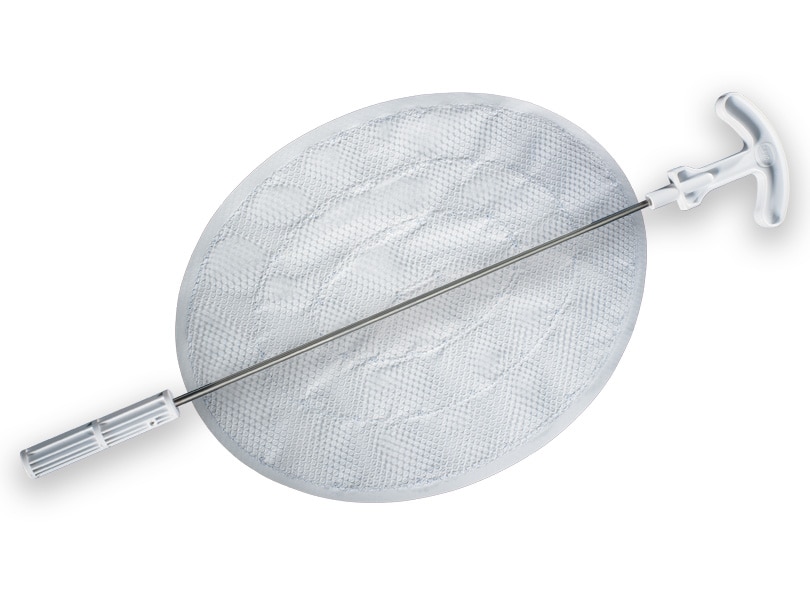Composix™ L/P Mesh
Low-profile, large pore polypropylene/ePTFE prosthesis for laparoscopic ventral hernia repair.


- Overview
- EIFU & Resources
A low-profile, large pore polypropylene/ePTFE prosthesis for laparoscopic ventral hernia repair.
The Composix™ L/P Mesh is a lightweight, low profile prosthesis that fits easily through a trocar and offers a permanent barrier that is designed to minimize visceral attachment. The parietal side of the Composix™ L/P Mesh features large pore, lightweight polypropylene Bard™ Soft Mesh which encourages rapid tissue ingrowth for a strong repair while leaving less foreign material in the body. The visceral side features Bard® submicronic permanent ePTFE barrier with over 12 years of clinical success in minimizing tissue attachment.

- Low profile, large pore polypropylene Soft Mesh is approximately 60% lighter than Bard™ Mesh
- Soft, compliant, biocompatible knit structure
- Easy handling and laparoscopic insertion – all sizes can be deployed through a trocar
- Optional Introducer Tool makes mesh insertion even easier
- ePTFE barrier helps minimize tissue attachment to the prosthesis
- Monofilament polypropylene mesh provides fast tissue ingrowth and incorporation, eliminating the need for permanent transfixation sutures

- Bard™ submicronic ePTFE permanent barrier
- Lightweight monofilament polypropylene
- Materials used in general surgery for many years with demonstrated clinical success
INDICATIONS
Bard™ Composix™ L/P Mesh is indicated for use in the reconstruction of soft tissue deficiencies, such as for the repair of hernias and chest wall defects.
CONTRAINDICATIONS
- Literature reports there may be a possibility for adhesion formation when the polypropylene is placed in direct contact with the bowel or viscera.
- Do not use the Bard™ Composix™ L/P Mesh in infants or children whereby future growth will be compromised by use of such material.
- Do not use Bard™ Composix™ L/P Mesh for the reconstruction of cardiovascular defects.
PRECAUTIONS
Davol fixation devices or nonabsorable monofilament sutures are recommended to properly secure the prosthesis. If other fixation devices are used, they must be indicated for use in hernia repair. Care should be taken to ensure that the prosthesis is adequately fixated to the abdominal wall. If necessary, additional fasteners and/or sutures should be used.
WARNINGS
- Ensure proper orientation; the solid white surface (ePTFE) must be oriented against the bowel or sensitive organs. Do not place the polypropylene mesh surface against the bowel. There may be a possibility for adhesion formation when polypropylene mesh is placed in direct contact with the bowel or viscera.
ADVERSE REACTIONS
Possible complications include seroma, adhesions, hematomas, inflammation, extrusion, fistula formation and recurrence of the hernia or soft tissue defect.
Please consult package insert for more detailed safety information and instructions for use.
BD-14807
BD offers training resources to help improve your clinical practices as part of our goal of advancing the world of health.
BD supports the healthcare industry with market-leading products and services that aim to improve care while lowering costs. We host and take part in events that excel in advancing the world of health™.
INDICATIONS
Bard™ Composix™ L/P Mesh is indicated for use in the reconstruction of soft tissue deficiencies, such as for the repair of hernias and chest wall defects.
CONTRAINDICATIONS
Literature reports there may be a possibility for adhesion formation when the polypropylene is placed in direct contact with the bowel or viscera. Do not use the Bard™ Composix™ L/P Mesh in infants or children whereby future growth will be compromised by use of such material.
Do not use Bard™ Composix™ L/P Mesh for the reconstruction of cardiovascular defects.
PRECAUTIONS
Davol fixation devices or nonabsorable monofilament sutures are recommended to properly secure the prosthesis. If other fixation devices are used, they must be indicated for use in hernia repair. Care should be taken to ensure that the prosthesis is adequately fixated to the abdominal wall. If necessary, additional fasteners and/or sutures should be used.
WARNINGS
Ensure proper orientation; the solid white surface (ePTFE) must be oriented against the bowel or sensitive organs. Do not place the polypropylene mesh surface against the bowel. There may be a possibility for adhesion formation when polypropylene mesh is placed in direct contact with the bowel or viscera.
ADVERSE REACTIONS
Possible complications include seroma, adhesions, hematomas, inflammation, extrusion, fistula formation and recurrence of the hernia or soft tissue defect.
Please consult package insert for more detailed safety information and instructions for use.
